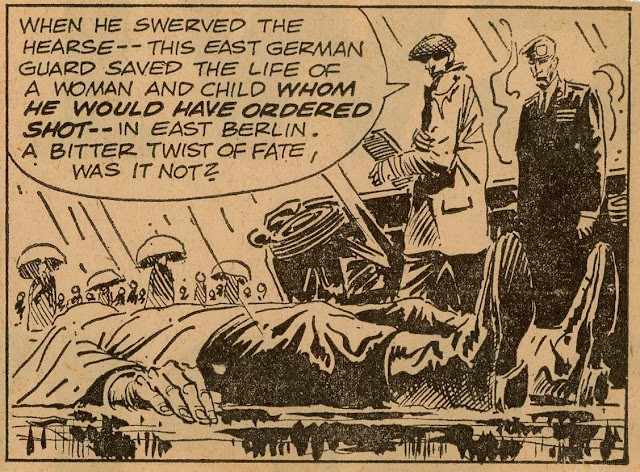Comic pages of the 1960s contained a rich variety of drawing styles by some of the top pen and ink artists of their day. Among those artists, none was a more fearless inker than Joe Kubert. He was a daredevil of hydrology, and his Tales of the Green Beret was a showcase for his bold, rapid brushwork.
Many strips in the 60s were drawn with "pretty" lines in the tradition of Alex Raymond or Stan Drake. Cartoonists favored styles that would be easy to digest in the morning newspaper along with breakfast. Not Kubert. The dense, inky style of Green Beret was rougher than most strips, yet it was every bit as sophisticated.
Note how selectively-- but effectively-- Kubert uses fine lines:
These strips appeared when the war in Vietnam was still a hot war. When you turn over these yellowed clippings, you find the ghosts of a tragic and painful period.
No comic strip today would dare to deal with such a hot, controversial topic.
Many comic book artists dreamed of getting a syndicated comic strip. Veteran comic book artists such as Al Williamson and Leonard Starr drew important strips in the 60s. Kubert had been drawing comic books since 1942, but he clearly brought his best game to Tales of the Green Beret in 1965.











This is a very good series. All the artists you've posted are new to me.
ReplyDeleteIn Britain in the 60s, Wally Fawkes (aka "Trog") was drawing Flook
https://www.lambiek.net/artists/t/trog.htm
and Tony Weare was drawing Matt Marriot
https://www.lambiek.net/artists/w/weare_tony.htm
Unfortunately there are no big reprint books here, unlike those for the great comics artists in the US.
Don Cox
I did not know Kubert’s work very well and I discover that Bernet is heavily influenced by his work
ReplyDeleteJoe Kubert's G.I.Joe was one of my favorites comic books as a kid, he was great.
ReplyDeleteDo something on Russ Heath.
When young, we sometimes mistake over-rendering for skill. When I was growing up and discovering great comic art, I didn't appreciate Kubert's pencraft ease and commanding use of a few well-placed strokes and dense areas of black (with deceptive forethought) in favor of the fetishistic rendering of every nut and bolt on an impossibly conceived spaceship of lesser draftsmen.
ReplyDeleteJoe Kubert knew how to let diffused light into the panels, letting imagination bleed between the lines, and in so doing, gave the uninitiated like me our first taste of comic strip post-impressionism. Thank you for another great installment!
"Joe Kubert's G.I.Joe was one of my favorites comic books as a kid, he was great."
ReplyDeleteI always thought Kubert modeled the facial features of his male protagonists, particularly Sgt.Rock, on Hollywood actor Eric Fleming.